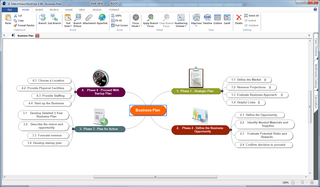Related Research Articles

A mind map is a diagram used to visually organize information into a hierarchy, showing relationships among pieces of the whole. It is often created around a single concept, drawn as an image in the center of a blank page, to which associated representations of ideas such as images, words and parts of words are added. Major ideas are connected directly to the central concept, and other ideas branch out from those major ideas.
Documentation is any communicable material that is used to describe, explain or instruct regarding some attributes of an object, system or procedure, such as its parts, assembly, installation, maintenance and use. As a form of knowledge management and knowledge organization, documentation can be provided on paper, online, or on digital or analog media, such as audio tape or CDs. Examples are user guides, white papers, online help, and quick-reference guides. Paper or hard-copy documentation has become less common. Documentation is often distributed via websites, software products, and other online applications.

FreeMind is a free mind mapping application written in Java, which is further developed by the fork Freeplane until today (2021). FreeMind itself was last updated in 2014. FreeMind is licensed under the GNU General Public License Version 2. It provides extensive export capabilities. It runs on Microsoft Windows, Linux, and macOS via the Java Runtime Environment.
Service design is the activity of planning and arranging people, infrastructure, communication and material components of a service in order to improve its quality, and the interaction between the service provider and its users. Service design may function as a way to inform changes to an existing service or create a new service entirely.

Telit is an Internet of Things (IoT) Enabler company headquartered in Irvine, CA, USA. It is a privately held company with key operations in the US, Brazil, Italy, Israel, and Korea.
User experience design is the process of defining the experience a user would go through when interacting with a digital product or website. Design decisions in UX design are often driven by research, data analysis, and test results rather than aesthetic preferences and opinions. Unlike user interface design, which focuses solely on the design of a computer interface, UX design encompasses all aspects of a user's perceived experience with a product or website, such as its usability, usefulness, desirability, brand perception, and overall performance. UX design is also an element of the customer experience (CX), which encompasses all aspects and stages of a customer's experience and interaction with a company.

Open Journal Systems, also known as OJS, is a free software for the management of peer-reviewed academic journals, created by the Public Knowledge Project, and released under the GNU General Public License.
The following outline is provided as an overview of a topical guide to design:

MindManager is a commercial mind mapping software application developed by Mindjet. The software provides ways for users to visualize information in mind maps and flowcharts. MindManager can be used to manage projects, organize information, and for brainstorming.

The Visual Understanding Environment (VUE) is a free, open-source concept mapping application written in Java. The application is developed by the Academic Technology group at Tufts University. VUE is licensed under the Educational Community License. VUE 3.0, the latest release, was funded under a grant from the Andrew W. Mellon Foundation.

Mindjet is a mind mapping and innovation management software company headquartered in San Francisco, California. Mindjet's software products, including its flagship product MindManager and SpigitEngage, are designed to visually and collaboratively manage information and tasks. As of June 2016, Mindjet had approximately sixteen million users.

Mindomo is a versatile freemium collaborative mind mapping, concept mapping and outlining tool developed by Expert Software Applications. It can be used to develop ideas and interactively brainstorm, with features including sharing, collaboration, task management, presentation and interactive web publication.

Compendium is a computer program and social science tool that facilitates the mapping and management of ideas and arguments. The software provides a visual environment that allows people to structure and record collaboration as they discuss and work through wicked problems.

MindMeister is an online mind mapping application that allows its users to visualize, share and present their thoughts via the cloud. MindMeister was launched in 2007 by MeisterLabs GmbH, a software company founded by Michael Hollauf and Till Vollmer. After 10 years in the market, MindMeister has more than 7 million users who created more than a billion ideas to date.

Mind42 is an online mind mapping application that allows users to visualize their thinking using the proven mind mapping method. The name refers to the collaborative features of the product, and is intended to be pronounced like "mind for two." It has been recommended by Freelance Weekly as one of their favorite time-management and organization tools.
ConceptDraw OFFICE is a proprietary office software suite of business productivity tools, developed by Computer Systems Odessa for use with either Microsoft Windows and macOS operating systems. ConceptDraw OFFICE is composed of mind mapping, project management and business diagramming tools. The three components use the cross-format exchange technology, allowing users to employ a visual approach to information management whereby the same set of data can be shown as a mind map, Gantt chart, or business graphic design.

ConceptDraw MINDMAP is proprietary mind mapping and brainstorming software developed by CS Odessa for Microsoft Windows and Apple macOS operating systems.
System information modelling (SIM) is the process of modelling complex connected systems. System information models are digital representations of connected systems, such as electrical instrumentation and control, power, and communication systems. The objects modelled in a SIM have a 1:1 relationship with the objects in the physical system. Components, connections and functions are defined and linked as they would be in the real world.

MindView is a mind mapping and project management software owned by the company MatchWare. MindView is used for mind mapping, concept mapping, work breakdown structures, timelines, Gantt charts, organizational charts, and other visuals.
Creately is a SaaS visual collaboration tool with diagramming and design capabilities designed by Cinergix. Creately has two versions: an online cloud edition and a downloadable offline edition for desktop which is compatible with Windows, Mac and Linux. The application is mostly known for creating flowcharts, organization charts, project charts, UML diagrams, mind maps, and other business visuals.
References
- ↑ Tae, Lee (7 August 2007). "IT Preparing for a sermon with the digital mind map 'Thinkwise'". christiantoday.co.kr.
- 1 2 News (22 May 2018). "Simtech System 'Thinkwise PQ'". m.etnews.com.
{{cite news}}:|last1=has generic name (help) - ↑ Young-gyo, Jung (29 March 2020). "Breakthrough in the era of the 4th industrial revolution 'Digital Project Capability (PQ)'". it.chosun.com.
- ↑ Seong-joong, Ko (13 February 2017). "Two Patterns of Mind Map Utilization". civilreporter.co.kr (in Korean).
- ↑ Staff. "MindMapper Reviews: Software Features 2022". Financesonline.com.
- ↑ "심테크시스템, 신개념 협업도구 '씽크와이즈 팀스피릿' 출시". ITWorld Korea. 21 May 2018.
- ↑ Shin, Joo-ah (December 8, 2021). "Simtech Systems to hold ThinkWise user conference". masil.or.kr.
- ↑ Soo-in, Jo (3 February 2021). "Introduction to effective non-verbal communication in non-face-to-face classes". www.dailycc.net (in Korean).
- ↑ Lesley, Marsha; Floyd, Judith; Oermann, Marilyn (November 2002). "Use of MindMapper software for research domain mapping". Computers, Informatics, Nursing: CIN. 20 (6): 229–235. doi:10.1097/00024665-200211000-00008. PMID 12464737. S2CID 8899044.
- ↑ "MindMapper in 2022 - Reviews, Features, Pricing, Comparison". PAT RESEARCH: B2B Reviews, Buying Guides & Best Practices. 28 July 2018.